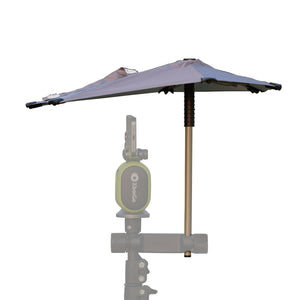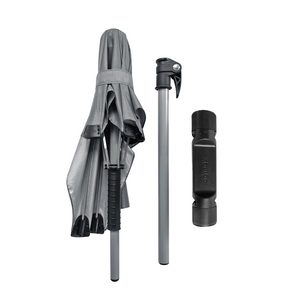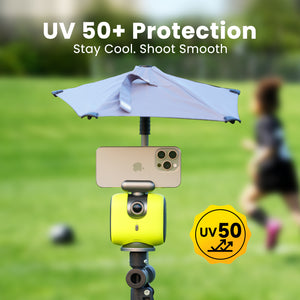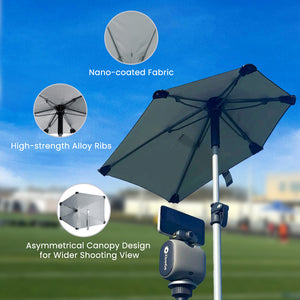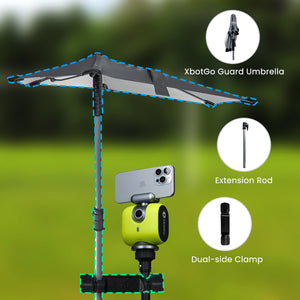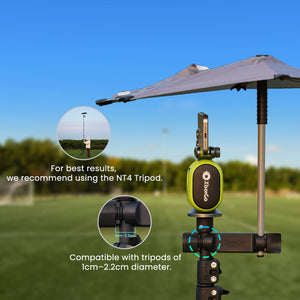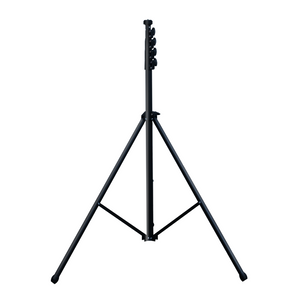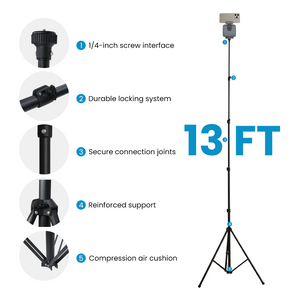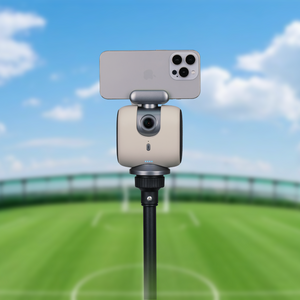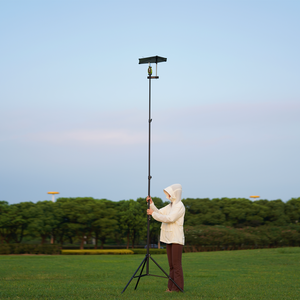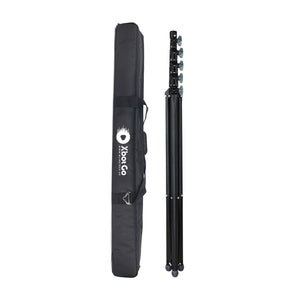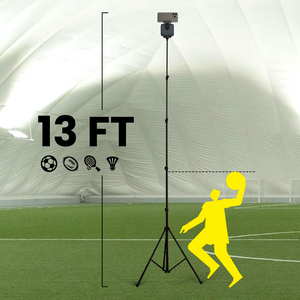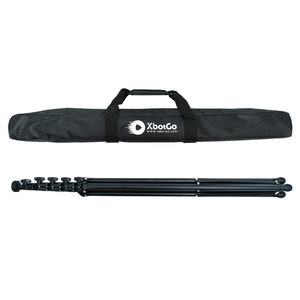XbotGo Chameleon AI Sports Camera
How to Improve Soccer Skills by Yourself?
You're standing in your backyard with just a soccer ball, wondering if you can really get better without a team. Maybe you're 23 and feeling like you've missed the boat. Or perhaps you're a teenager with no ride to practice. Here's the truth: some of the world's best players built their foundation practicing alone, and you can too.
After analyzing thousands of player experiences and expert recommendations, I've discovered that solo training isn't just a substitute for team practice—it's often where the real magic happens. Whether you're juggling in your bedroom or passing against a garage wall, every touch counts toward mastery.
This guide breaks down exactly how to transform your solo practice sessions into powerful skill-building workouts. You'll learn the proven drills that work, understand why they're effective, and discover how to track your progress without a coach watching. Most importantly, you'll see why starting today—regardless of your age or equipment—is the best decision you can make for your soccer development.
Why Solo Practice is Essential for Soccer Development
Team practice teaches you tactics and teamwork, but solo training is where you build the technical foundation that sets you apart. Think about it: in a typical 90-minute team session with 20 players and 3 balls, you might touch the ball 50 times. In 30 minutes alone with one ball, you can easily get 500+ touches.
Research in motor learning shows that repetition creates neural pathways, turning complex movements into automatic responses. When you practice juggling alone, your brain builds connections that eventually let you trap a difficult pass without thinking. This "muscle memory" only develops through consistent, focused repetition—exactly what solo training provides.
The mental benefits might surprise you even more. Players report that solo practice becomes meditative, offering stress relief while building confidence. Every successful juggling session or clean wall pass builds self-belief that carries into games. Without teammates watching, you're free to fail, experiment, and push your limits without judgment.
Solo training also eliminates common excuses. No practice scheduled? Train anyway. Team canceled? Perfect opportunity for focused skill work. Bad weather? Find a wall indoors. When you take ownership of your development, you control your destiny rather than depending on others' schedules.
Foundational Skills You Can Master Alone
Juggling: The Universal Starting Point
Juggling isn't just a party trick—it's the foundation of elite ball control. Start by dropping the ball onto your dominant foot and popping it back to your hands. Once you can do this 10 times consecutively, try keeping it in the air for multiple touches.
Here's the progression path that works:
- Week 1-2: Focus on 5-10 consecutive touches with your dominant foot
- Week 3-4: Alternate feet every touch, accepting that the ball will drop often
- Week 5-6: Introduce thigh touches between foot touches
- Week 7+: Add chest, shoulders, and head while maintaining control
The secret is tracking your progress. Keep a simple log of your best streak each day. When you hit 25 consistently, you'll find 50 comes quickly. At 50, the path to 100 opens up. This tangible progress builds confidence faster than any other drill.
Remember: pros don't juggle 1,000 times because they're showing off. They do it because juggling develops the micro-touches and body awareness that separate good players from great ones.

XbotGo Chameleon AI Sports Cameraman
Capture every moment with AI-powered tracking. Perfect for parents, coaches, athletes, and creators who want seamless footage without manual filming.
First Touch Mastery Through Repetition
Your first touch determines everything that follows. Practice it by tossing the ball high and controlling it as it drops. Start with inside-foot cushion touches, then progress to outside foot, thigh, and chest control.
The "throw and control" progression:
- Toss the ball 6 feet high, control with inside foot
- Increase to 10 feet, control while ball is still bouncing slightly
- Add movement—control and immediately push into space
- Vary the receiving surface: outside foot, thigh, chest
- Challenge yourself: control and turn in one motion
Focus on "killing" the ball's momentum rather than just making contact. A perfect first touch leaves the ball exactly where you want it for your next move. This skill alone will transform your game more than any fancy footwork.

Ball Control Patterns That Build Coordination
Solo ball control work teaches your feet to work independently while your mind stays calm. Start with basic patterns and add complexity as movements become natural.
Essential patterns to master:
- Inside touches only: Roll the ball between feet using only inside surfaces
- Outside touches only: Push the ball with outside foot surfaces in figure-8 patterns
- Sole rolls: Forward, backward, and side-to-side using only the bottom of your foot
- Mixed patterns: Combine inside-outside-sole in set sequences
Practice these in 30-second bursts with 30-second rest periods. Start slowly—technique beats speed every time. Once movements feel natural, increase tempo while maintaining precision. The goal is making complex footwork feel as natural as walking.
Wall Training: Your 24/7 Practice Partner
If you only have time for one solo training method, make it wall work. A wall never gets tired, always returns the ball, and provides instant feedback on your technique. Professional players from Paul Scholes to Ronaldinho credit wall training as fundamental to their development.
Essential Wall Passing Drills
Start 3-5 feet from the wall with these progressions:
Basic Two-Touch:
- Pass with inside right foot
- Control return with inside left foot
- Pass with inside left foot
- Control return with inside right foot
- Continue alternating for 60 seconds
One-Touch Challenge:
- Stand closer (2-3 feet)
- Return ball immediately without controlling
- Focus on clean contact and accuracy
- Start with 10 consecutive passes, build to 50+
Movement Integration:
- Pass, control, and move laterally before next pass
- Add shoulder checks between touches
- Vary passing angles to simulate game situations
The beauty of wall training is its scalability. Beginners work on basic passing while advanced players add complex movements and faster speeds. The wall always matches your level.
Creative Wall Exercises for Game Situations
Transform wall training from repetitive passing into game simulation:
The Give-and-Go: Pass firmly to the wall, sprint past an imaginary defender, receive the return pass in stride. This mimics the most common attacking combination in soccer.
Pressure Training: Set a timer for 30 seconds. See how many clean wall passes you can complete while moving constantly. This builds composure under time pressure.
Weak Foot Focus: Dedicate entire sessions to your non-dominant foot. Yes, it feels awkward initially, but this discomfort signals growth. Players who commit to weak foot development double their options on the field.
Remember to vary your distance, angle, and pace. The wall should simulate different game scenarios, not just repetitive motion.
Solo Dribbling and Agility Development
You don't need expensive cones or agility ladders. Grab some shoes, water bottles, or any household objects to create your dribbling course. The key is consistent practice with progressive difficulty.
Cone Dribbling Alternatives Using Household Items
Create a line of 5-6 objects spaced 2 feet apart:
The Weave: Dribble through objects using only outside touches, then return using only inside touches. Focus on keeping the ball close and maintaining rhythm.
Speed Progression:
- Week 1: Focus on clean technique at walking pace
- Week 2: Increase to jogging pace
- Week 3: Add time pressure (how fast can you complete 5 rounds?)
- Week 4: Reduce spacing between objects for tighter control
Creative Challenges:
- Backwards dribbling through objects
- Using only weak foot
- Combining moves (stepover at each object)
- Adding 360-degree turns
The goal isn't just getting through the course—it's maintaining close control while building speed and adding complexity.

Speed and Agility Without Equipment
Footwork and agility improve through consistent movement patterns:
Box Drill (No Cones Needed):
- Imagine a 2-foot square on the ground
- Step in pattern: forward-right-back-left
- Add ball touches between steps
- Increase speed while maintaining precision
Shadow Dribbling:
- Dribble at varying speeds in random patterns
- Include sudden stops and direction changes
- Add fake shots and stepovers
- Focus on selling the movement, not just doing it
Sprint-Touch Intervals:
- Sprint 10 yards with ball
- Stop and perform 20 quick touches
- Sprint back
- Repeat 10 times
These exercises build the explosive movements and quick feet that separate average players from impact players.

Shooting Practice Without a Goal
Limited space doesn't mean limited shooting practice. Focus on technique and accuracy rather than power.
Target Practice Methods
Wall Targets:
- Mark spots on a wall with tape or chalk
- Start 10 feet away, focus on hitting targets consistently
- Progress to one-touch finishing from self-passes
- Add movement before shooting
Accuracy Over Power Progression:
- Master side-foot placement shots first
- Add inside-foot curves
- Progress to laces for power
- Combine techniques based on distance
The Repetition Rule: Take 10 shots at the same target with the same technique before moving on. This builds muscle memory faster than random shooting.
Developing Both-Foot Finishing
Dedicate entire sessions to weak-foot shooting:
Weak Foot Protocol:
- Start closer to target than normal
- Focus on clean contact, not power
- Take 2x more repetitions than strong foot
- Gradually increase distance as technique improves
Track your accuracy: If you hit 7/10 targets with your strong foot but only 3/10 with weak foot, you've identified clear improvement opportunity. Most players neglect weak foot development, making it your secret weapon.

Building Mental Strength Through Solo Training
The mental game often determines who succeeds, and solo training builds psychological strengths that team practice can't match.
Visualization Techniques During Practice
Every touch should have purpose. Before each drill:
- Visualize the game scenario you're preparing for
- Imagine defenders pressuring you
- Picture teammates making runs
- Feel the game intensity
During wall passing, don't just hit the ball—imagine you're playing quick combinations to break pressure. While dribbling through cones, visualize beating a defender in the final third. This mental rehearsal programs your brain for game situations.
Setting and Tracking Personal Goals
Create measurable objectives:
- Daily: "Complete 100 consecutive juggles"
- Weekly: "Increase wall passing streak by 10"
- Monthly: "Master 3 new skill moves"
Track progress in a simple notebook:
- Date
- Drill performed
- Best achievement
- Notes on what felt good/challenging
This tangible progress record provides motivation during difficult days and proves improvement over time.

XbotGo Chameleon AI Sports Cameraman
Capture every moment with AI-powered tracking. Perfect for parents, coaches, athletes, and creators who want seamless footage without manual filming.
Overcoming the "Too Late to Start" Mentality
If you're starting at 20+ years old, you're in good company. Many successful players began "late" and developed through dedicated solo practice. The key mindset shifts:
- Compare yourself to yesterday's version, not to others
- Celebrate small wins (first 10 juggles feels as good as someone else's 100)
- Focus on enjoyment—adults often progress faster because they choose to practice
- Use maturity as advantage—you understand discipline and systematic improvement
Remember: A 25-year-old who practices daily will surpass a talented 16-year-old who relies on ability alone.
Creating Your Personal Training Schedule
Consistency beats intensity. Here's how to structure sustainable solo training:
Sample 30-Minute Daily Routines
Beginner Routine:
- 5 min: Warm-up juggling (track personal best)
- 10 min: Wall passing (two-touch, then one-touch)
- 10 min: Cone dribbling with household items
- 5 min: Weak foot focus (juggling or passing)
Intermediate Routine:
- 5 min: Complex juggling patterns
- 8 min: Wall combinations with movement
- 8 min: Speed dribbling with direction changes
- 5 min: Shooting accuracy practice
- 4 min: High-intensity skill moves
Advanced Routine:
- 3 min: Freestyle juggling warm-up
- 10 min: Game-situation wall drills
- 7 min: Complex dribbling patterns at speed
- 7 min: Finishing from various angles
- 3 min: Pressure skills (timed challenges)
Adjust based on your schedule, but maintain consistency. Daily 20-minute sessions beat weekly 2-hour marathons.
Progressive Difficulty Scaling
Month 1: Foundation Building
- Master basic techniques
- Build consistency habits
- Track baseline numbers
Month 2: Speed Introduction
- Maintain technique while adding pace
- Introduce time pressure
- Expand drill variety
Month 3: Complexity Addition
- Combine multiple skills
- Add decision-making elements
- Simulate game pressure
Month 4+: Mastery Refinement
- Focus on weak areas
- Create custom challenges
- Maintain what's working
The key is patient progression. Rushing leads to bad habits that take longer to fix than learning correctly initially.
Common Mistakes to Avoid
Skipping Warm-Ups
"It's just practice" thinking leads to injuries and poor habits. Always start with:
- Light juggling or ball rolls
- Dynamic stretching
- Progressive intensity buildup
This 5-minute investment prevents weeks of injury recovery and improves practice quality.
Focusing Only on Dominant Foot
Your weak foot is your biggest improvement opportunity. If you avoid it:
- Defenders identify and exploit this weakness
- You become predictable
- You miss scoring opportunities
Dedicate at least 30% of practice time to weak foot development. Yes, it's frustrating initially, but the payoff is massive.
Practicing Without Purpose
Random juggling or aimless dribbling provides minimal improvement. Every session needs:
- Clear objectives
- Specific techniques to improve
- Progress measurement
- Game situation context
"I'll just kick around for a while" rarely leads to improvement. "I'll complete 50 wall passes with each foot, focusing on clean first touches" drives real progress.
Tracking Your Progress
Without a coach observing, you must become your own evaluator:
Simple Metrics to Monitor
Daily Tracking:
- Juggling record (consecutive touches)
- Wall passing streaks
- Successful shots on target
- Time to complete dribbling course
Weekly Review:
- Which skills improved?
- What felt more natural?
- Where did you struggle?
- What needs more focus?
Monthly Assessment:
- Film yourself performing drills
- Compare to previous month
- Note technique improvements
- Celebrate progress made
The 1% Rule: Aim for tiny daily improvements. Getting 1% better daily means doubling your ability in 70 days. This compounds into dramatic improvement over months.
When to Move to Advanced Techniques
Progress indicators for advancement:
- Current drills feel "too easy"
- Technique remains clean at high speed
- Consistency across multiple sessions
- Mental capacity for added complexity
Don't rush advancement. Master basics thoroughly—they remain important at every level. Pros still juggle and do wall passes daily because fundamentals never stop mattering.
Conclusion
Solo soccer training isn't just a backup plan when team practice isn't available—it's where dedicated players separate themselves from the pack. Every touch you take alone, every wall pass in your garage, every juggling session in your bedroom adds up to real improvement that shows on game day.
Remember the key principles: consistency beats intensity, patience produces progress, and creativity conquers equipment limitations. Whether you're 16 or 26, whether you have a full field or just a wall, whether you're beginning or advancing, solo training transforms your game if you commit to it.
Start today with just 20 minutes. Pick one drill from this guide—maybe it's juggling to 25 or completing 50 wall passes. Track your number. Tomorrow, try to beat it. In a week, you'll see progress. In a month, you'll feel different on the ball. In a year, you'll be unrecognizable as a player.

XbotGo Chameleon AI Sports Cameraman
Capture every moment with AI-powered tracking. Perfect for parents, coaches, athletes, and creators who want seamless footage without manual filming.
XbotGo Chameleon AI Sports Camera
Capture every moment with AI-powered tracking. Perfect for coaches, parents, and athletes who want seamless footage without manual filming.







 Soccer
Soccer Basketball
Basketball Ice Hockey
Ice Hockey Rugby
Rugby










